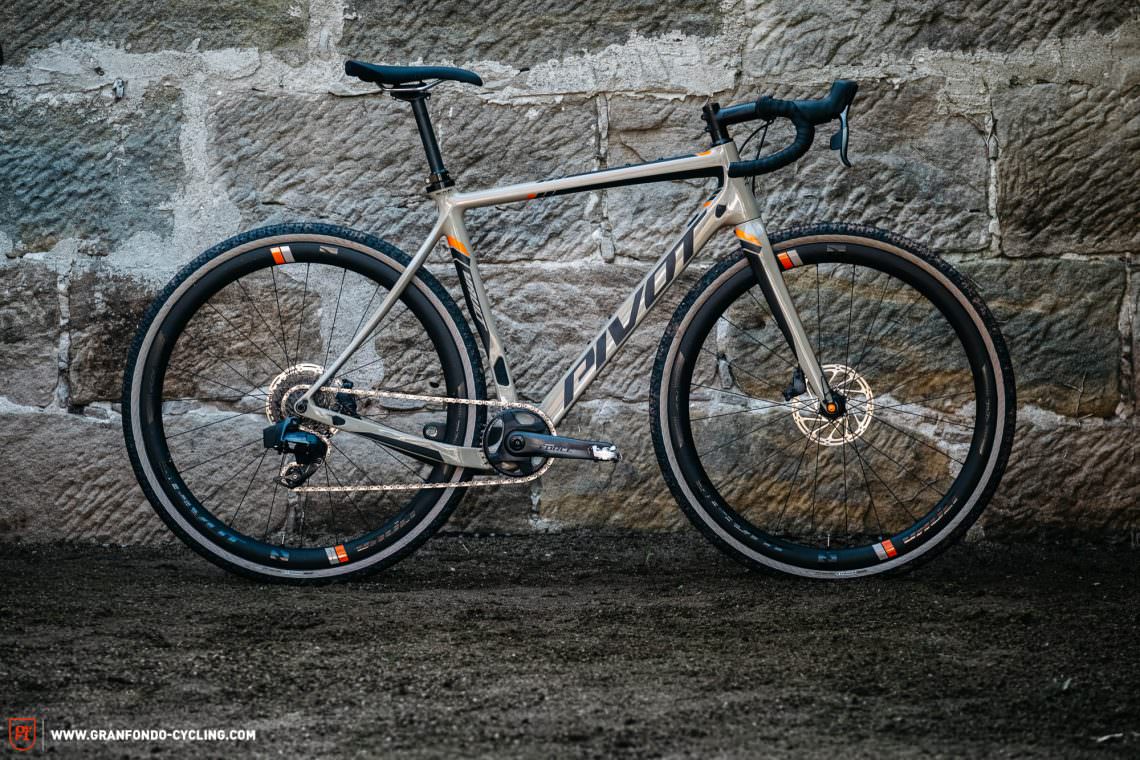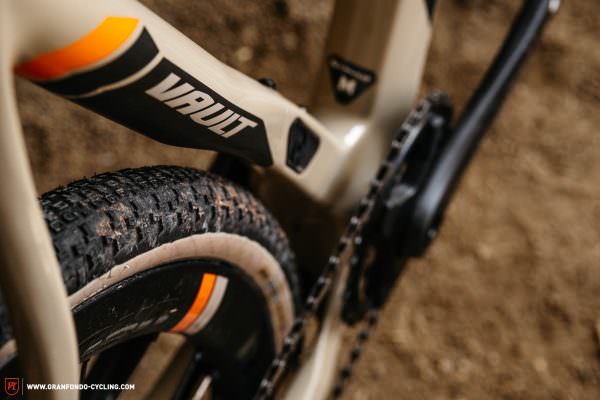Pivot are known for their exclusive mountain bikes and as well as their years of accumulated carbon know-how. For their 2019 range, the Arizona-based company have introduced the progressive Pivot Vault Team Force gravel bike. Does it hit a hole in one? We’ve got the answer!
Click here for an overview of the best gravel bike 2020 group test.

The development priorities for the Vault put a particular focus on speed and versatility. In turn, this bike will take anything from 700 x 47C tires to 650 x 50B tires. Not stopping there, the carbon frame is also compatible with gravel suspension such as the FOX 32 Step-Cast AX or the Lauf Grit suspension fork. But even without, the frame is designed to offer a high level of comfort with its specially engineered ISO FLEX system. This comprises an elastomer insert in the seat tube which decouples the seatpost from the frame, offering a higher level of compliance. The ISO FLEX system is compatible with 27.2 and 30.9 mm seatposts, and even 30.9 mm dropper posts with internal routing. A further advantage of this system is that similar to the Trek Domane 9 SLR, it doesn’t impact on the torsional stiffness of the bottom bracket and head tube. The organic shaping of the frame matches current trends and the finish is of the highest quality. It’s only the loud decals that split opinions amongst our test team. Our test bike in size M weighed 8.34 kg and was equipped with a complete 1×12 SRAM Force eTap AXS groupset with a 36 t chainring, 10-33 t cassette, Reynolds ATRx 23 carbon wheels and 700 x 40C MAXXIS Rambler EXO TR tires. In this spec, the Pivot costs € 8,049. The frameset only option costs € 3,249.

The Pivot Vault Team Force in detail
Drivetrain SRAM Force eTap AXS
Gearing 36 t and 10-33 t, 1×12
Brakes SRAM Force HRD, 160/160 mm
Handlebar Easton EC70 AX, 440 mm
Stem Phoenix Team, 110 mm
Seatpost Phoenix Pro Carbon, 20 mm offset
Wheels Reynolds ATRx 23
Tires MAXXIS Rambler EXO TR 700 x 40C

The MAXXIS Rambler tires don’t just match the frame aesthetically, they also offer a high level of grip and good comfort.

The wireless SRAM Force eTAP AXS groupset means there are only two brakes hoses left to manage. Despite this, the internal routing rattled a lot on our test bike.

The design language is consistent throughout the frameset. A front derailleur can be mounted if required.

The ISO FLEX system offers comfort even with the inevitably stiff design of dropper posts. An excellent idea with excellent implementation!
| Size | XS | SM | MD | LG | XL |
|---|---|---|---|---|---|
| Seat tube | 445 mm | 538 mm | 548 mm | 568 mm | 588 mm |
| Top tube | 515 mm | 538 mm | 565 mm | 578 mm | 590 mm |
| Head tube | 105 mm | 130 mm | 155 mm | 170 mm | 195 mm |
| Head angle | 70.0° | 71.5° | 72.0° | 72.0° | 72.0° |
| Seat angle | 74.8° | 74.0° | 73.5° | 73.0° | 73.0° |
| Chainstays | 420 mm | 420 mm | 420 mm | 420 mm | 420 mm |
| BB Drop | 70 mm | 70 mm | 70 mm | 70 mm | 70 mm |
| Wheelbase | 1,000 mm | 1,002 mm | 1,020 mm | 1,028 mm | 1,038 mm |
| Reach | 374 mm | 381 mm | 395 mm | 398 mm | 400 mm |
| Stack | 520 mm | 549 mm | 574 mm | 589 mm | 612 mm |
The Pivot Vault Team Force in review
Accelerating, the Pivot is decidedly agile and converts your input willingly into forward motion. It generates speed efficiently whether you’re on the road or gravel. The small gear steps allow you to maintain a steady cadence and ride quickly. Indeed, the bike demands of you to ride it sportily, especially as the road starts pointing up. That’s where the limited gear range reaches its limits and just can’t keep up with the versatility of 2x drivetrains or 500% range cassettes. Overall the combination of 20 mm offset seatpost, effective seat tube angle of 73.5° and 110 mm stem results in a stretched out position, reflecting the sporty design that suits riding hard better than it does relaxed cruising.

Bigger cassette for easier climbing


Heading out for some gravel fun? Then take the Pivot!
The playful and lively handling is well-balanced and will allow experienced riders to react quickly in tricky situations and hit tight corners at speed. However, gravel beginners should be aware of this trait when they approach technically demanding terrain. The Vault provides a calm and stable enough ride, but given its performance focus, it is less than some other bikes in the test. However, the level of comfort offered by the Pivot impressed our whole team! The ISO FLEX system was always effective, successfully damping bigger hits. This is also well matched by the carbon frame which absorbs vibrations effectively while maintaining its defined and precise handling. Given this positive impression, the rattling internally routed brake hoses leave a bitter aftertaste on what is an otherwise brilliant package.

Conclusion
The Pivot Vault Team Force generates lots of speed and convinced us with the clever ISO FLEX system and good vibration damping of the frameset itself. Experienced gravel riders will discover a lively and performance focussed premium bike. Gravel beginners will have to take into account the quick handling nature and relatively aggressive position. However, on a bike at this price point, rattling internal routing just shouldn’t be an issue anymore.
Tops
- playful handling without being nervous
- comfortable ride
- integration and versatility of the ISO FLEX system
Flops
- not the most stable ride
- rattling internal routing
- cassette is too small for steep ramps
Riding Characteristics
4Agility
- cumbersome
- playful
Stability
- nervous
- confident
Handling
- demanding
- balanced
Fun factor
- boring
- lively
Value for money
- terrible
- very good
For more info: pivotcycles.com
Click here for an overview of the best gravel bike 2020 group test.
All bikes in test: Argon 18 Dark Matter | Cannondale Topstone Carbon Ultegra RX | Canyon Grail AL 7.0 | Cervélo Áspero | Giant Revolt Advanced Pro Force | Kona Libre AL | Liteville 4-ONE MK1 | OPEN WI.DE. | Pivot Vault Team Force | ROSE BACKROAD GRX RX810 Di2 | Santa Cruz Stigmata CC | Specialized Turbo Creo SL Expert EVO | Standert Pfadfinder | Trek Domane SLR 9 eTap</a
No, it’s not about perfect race tracks, it’s about efficiency. Fast, fleet-footed and efficient – those who want to speed along high-speed passages need a defined and spritely bike that accelerates with ease and efficiency. Nevertheless, reliable components are important too. We interpret “Smooth tarmac” bikes as follows: Hard efforts at high speeds with a maximum efficient bike on a consistently well-paved road. Effort-joy ratio: 80:30 (not everything has to be 100%!)↩
… also known as bike riding. Broken-up roads in the hinterland, deadlocked gravel roads, loose surfaces – sometimes muddy, sometimes bone-dry. For this, it takes bikes with super all-round, handling and wearing qualities uphill and downhill. Effort-joy ratio: 50:50↩
If you want to use your bike almost every day, you usually do not need an extremely tuned racing machine. Solid components, which are able to cope with the rigours of continuous usage in any kind of weather, are part of the basic equipment. At the same time, the bike should have practicable details: integrated fenders/assembly options, luggage racks/attachment points and a light system or at least the option of installing bike lights. The position on the bike should be rather relaxed, the overall comfort high, so that the Afterwork Ride becomes a cure and not a curse. Effort-joy ratio: 30:70↩
You can find more info about our rating system in this article: Click here! ↩
Did you enjoy this article? If so, we would be stoked if you decide to support us with a monthly contribution. By becoming a supporter of GRAN FONDO, you will help secure a sustainable future for high-quality cycling journalism. Click here to learn more.
Words: Photos: GRAN FONDO-Team







